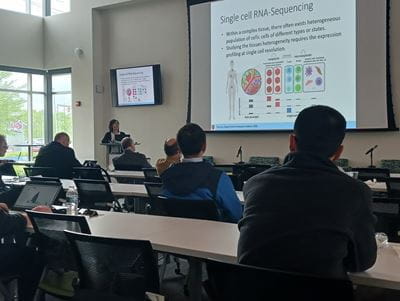Dr. Kun Huang, chair of the Department of Biostatistics and Health Data Science at IU School of Medicine, co-hosted the 3rd Annual Artificial Intelligence in Healthcare Innovation Conference, “Moving from Reactive to Proactive” with Dr. Shaun Grannis of the Regenstrief Institute. The hybrid conference was held March 25-27, 2023 at the Regenstrief building and online.
Several faculty members from the biostatistics department presented on various topics and moderated panel discussions. Researchers from Regenstrief, IU, IU Health, Eli Lilly, Harvard Medical School, Purdue University, Northwestern University and University of Notre Dame, and other institutions, also shared their work. Investigators used artificial intelligence (AI) in many ways both broad and specific, from improving computation speed and accuracy, to cleaning up data sets. AI was also able to see connections between data points that humans may not notice, improving diagnosis significantly.
Keynote speaker Kenneth Mandl explained that AI could be very effective at mundane tasks, such as taking notes and processing claims. Some organizations are piloting these AI programs, including insurance companies using AI to process claims. Dr. Mandl noted that the future of AI will rely on the accessibility of data. He teased future uses, as AI is learning to digitize scents. That data can be used to create perfumes, and for possible diagnosis, like pets who can smell disease.
 The panel discussions at the conference showcased work in progress already and sparking ideas about what AI could in the future. One important issue that was addressed often was the human biases that AI can learn. There were several ways of dealing with this, but the most important element was to recognize that they are present. An effective method was the careful assigning of tasks to AI. Some tasks are performed better by humans like resume screening, and some were performed better by AI, like reading x-rays and cell classification. There was an entire panel discussion devoted to ethics around AI, including recognizing health care disparities.
The panel discussions at the conference showcased work in progress already and sparking ideas about what AI could in the future. One important issue that was addressed often was the human biases that AI can learn. There were several ways of dealing with this, but the most important element was to recognize that they are present. An effective method was the careful assigning of tasks to AI. Some tasks are performed better by humans like resume screening, and some were performed better by AI, like reading x-rays and cell classification. There was an entire panel discussion devoted to ethics around AI, including recognizing health care disparities.
In addition to using AI behind the scenes to analyze data, some groups are using AI in the clinician’s office. One program was able to offer remote neurological diagnosis, using video of movements, patients captured from their cell phones. Those videos were then reduced to just the elements of movement. The videos could then be added to the database for machine learning while also being de-identified.
The future of AI is fascinating at best, and dangerous at worst. Many at the conference seemed to agree that guardrails were needed. Researchers also need to be thoughtful about the way machine learning is used. Its uses, so far, appear limited only by the imaginations and budgets of the investigators.
